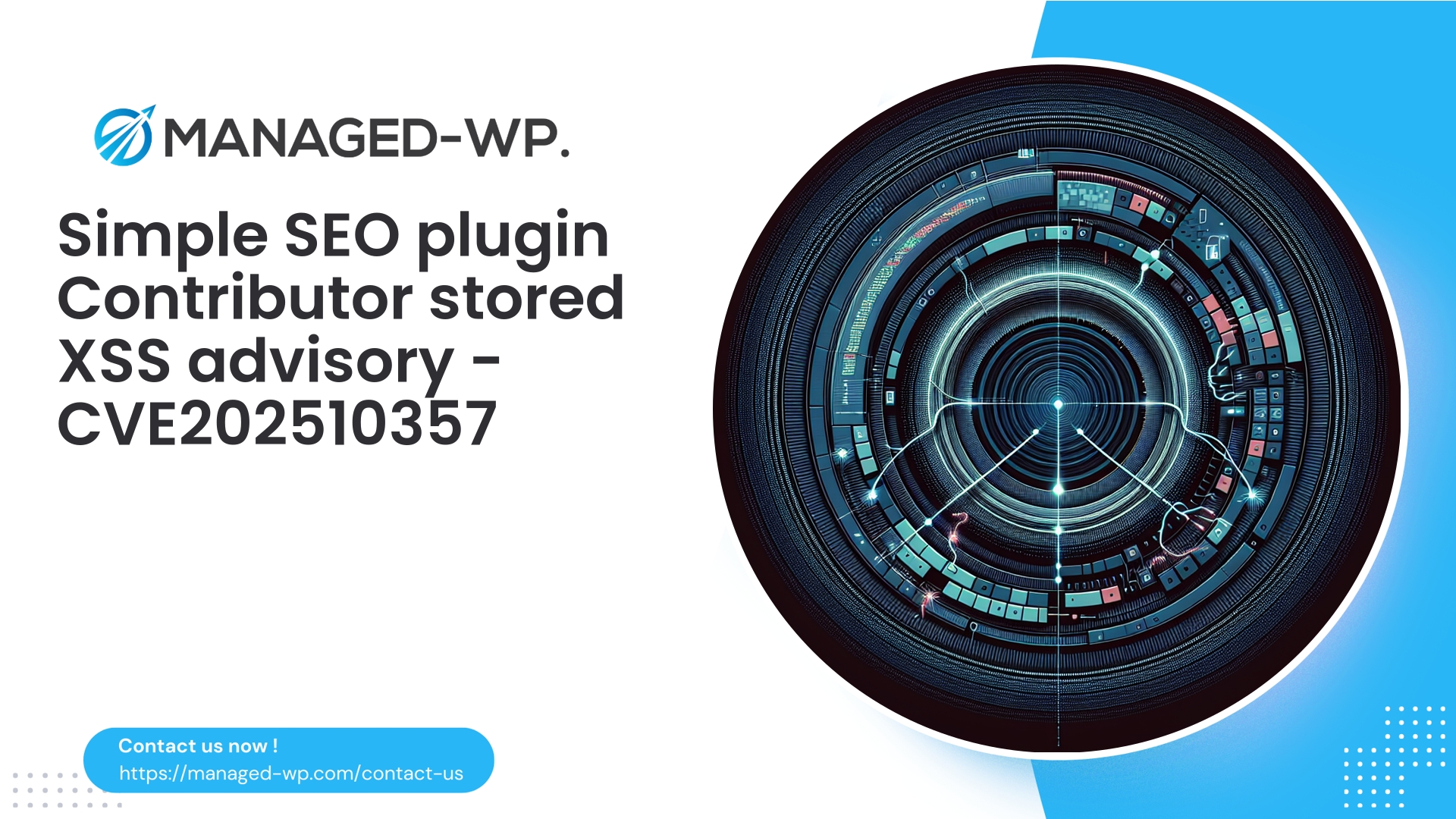| 插件名稱 | WPBakery 頁面建立器 |
|---|---|
| 漏洞類型 | 儲存型跨站腳本攻擊 |
| CVE編號 | CVE-2025-11160 |
| 緊急 | 低的 |
| CVE 發布日期 | 2025-10-15 |
| 來源網址 | CVE-2025-11160 |
WPBakery Page Builder <= 8.6.1 – 自訂 JS 模組中存在儲存型 XSS 漏洞 (CVE-2025-11160)
安全研究人員近期發現 WPBakery Page Builder 8.6.1 及更早版本中存在一個儲存型跨站腳本 (XSS) 漏洞,漏洞編號為 CVE-2025-11160。該漏洞允許擁有貢獻者等級存取權限的攻擊者利用插件的自訂 JS 模組,注入惡意 JavaScript 程式碼,這些程式碼會持久儲存並在您的網站上下文中執行。該漏洞已在 8.7 版本中修復。
Managed-WP 是一家專注於美國安全領域的公司,我們致力於透過託管式 Web 應用防火牆 (WAF) 服務積極保護 WordPress 生態系統。我們提供全面的安全情報和實踐指導,包括:
- 對漏洞進行清晰的技術性解釋
- 針對不同網站類型的情境風險評估
- 您可以立即執行有效的偵測和清理方法
- 短期防禦策略包括虛擬補丁和WAF配置
- 長期安全加固和持續監控建議
本簡報面向 WordPress 網站所有者、管理員、開發人員和安全專業人員,他們需要精準、可操作的建議——沒有廢話,只有結果。
摘要(TL;DR)
- 漏洞: WPBakery 自訂 JS 模組中存在儲存型 XSS 漏洞
- 受影響版本: WPBakery Page Builder 版本 ≤ 8.6.1
- 已修復: 版本 8.7
- CVE標識符: CVE-2025-11160
- 所需權限: 貢獻者(已認證的低權限使用者)
- CVSS評分: 6.5(中等,取決於站點配置)
- 主要風險: 持續在訪客瀏覽器中執行的 JavaScript 注入,可能導致會話被盜、網站被篡改、使用者重定向,並可能引發大規模攻擊。
- 立即補救措施: 升級至 WPBakery 8.7+,檢查儲存的內容是否有惡意腳本,套用 WAF 規則或虛擬補丁,並限制貢獻者新增自訂 JavaScript 的權限。
請繼續閱讀,以了解我們的詳細分析和補救路線圖。
了解儲存型 XSS 及其對 WordPress 的影響
儲存型跨站腳本攻擊(Stored XSS)是指惡意 JavaScript 程式碼被保存在網站的持久儲存區域(例如文章、頁面或外掛欄位)中,並以不安全的方式傳遞給其他使用者。與反射型 XSS 不同,儲存型 XSS 的有效載荷會在受感染的內容載入時執行,因此管理員和訪客都會受到影響。
此漏洞在 WordPress 平台上尤其嚴重,原因如下:
- 注入的腳本可以透過竊取身份驗證 cookie 來劫持管理員會話。
- 攻擊者可以嵌入更多惡意程式碼、設定永久重定向、修改可見內容或插入 SEO 垃圾郵件。
- 透過入侵貢獻者層級的帳戶並攻擊經常造訪的頁面(例如主頁或管理員預覽畫面),可以進行大規模攻擊。
這種漏洞源自於一個允許添加自訂 JavaScript 的插件功能。如果該功能未被選中,低權限使用者可以嵌入惡意腳本,任何查看該內容的使用者都會受到這些腳本的攻擊。
技術解析:此漏洞的工作原理
- WPBakery 外掛程式包含一個自訂 JS 模組,該模組將 JavaScript 程式碼作為頁面或文章元資料的一部分儲存在網站資料庫中。
- 由於儲存的輸入在顯示前缺乏足夠的清理,因此在內容渲染時可能會執行惡意腳本。
- 擁有「貢獻者」等級權限的攻擊者可以提供有效載荷,嵌入可在訪客瀏覽器中執行的 JavaScript 程式碼——包括預覽網站的管理員。
潛在攻擊場景:
- 攻擊者註入 JavaScript 程式碼,竊取管理員 cookie 並將其傳送到外部伺服器,從而實現對網站的完全控制。
- 惡意腳本會將訪客重新導向到惡意網域、載入惡意軟體或觸發加密貨幣挖礦等惡意操作。
- 利用動態 DOM 操作插入垃圾郵件、竊取表單資料或透過 AJAX 進一步提升權限。
筆記: 利用此漏洞需要已認證的貢獻者角色。因此,帳戶被盜用或用戶註冊公開都會為攻擊提供便利。
哪些人應該關注?
- 運行 WPBakery Page Builder 版本 8.6.1 或更早版本的網站。
- 允許低權限使用者註冊或以訪客身分提交內容的網站。
- 啟用投稿人角色的多作者部落格或平台。
- 管理員在登入狀態下經常預覽內容,這使他們容易受到注入腳本的攻擊。
如果您的網站符合這些標準中的任何一項,即使 CVSS 評級為中等,也需要立即關注此漏洞——真正的風險取決於上下文和攻擊者的存取權限。
緊急行動(最初 1-2 小時)
- 驗證 WPBakery 版本
– 透過控制面板或 WP-CLI 檢視:wp plugin get js_composer --field=version
- 更新至 WPBakery 8.7 或更高版本(如果可能)
– 如果許可證和相容性允許,請立即升級:wp plugin update js_composer --clear-plugins-cache
– 否則,在採取臨時緩解措施的同時,安排及時更新。
- 限制貢獻者角色存取權限
– 暫時移除或限制貢獻者權限,特別是與新增自訂 JS 模組相關的權限。
– 使用角色管理外掛程式來完善權限。 - 掃描是否存在惡意 JavaScript
– 搜尋貼文和貼文元數據<script標籤和可疑事件處理程序。SELECT ID, post_title FROM wp_posts WHERE post_content LIKE '%
SELECT post_id, meta_key FROM wp_postmeta WHERE meta_value LIKE '% - 將網站置於維護模式
– 在調查疑似漏洞利用事件期間限制存取權限。 - 備份資料庫和文件
– 在進行任何修復之前,建立乾淨的、帶有時間戳記的取證備份。
偵測惡意載重:查詢模式與建議
監控典型的腳本注入標記:
- tags
- 內聯事件屬性
錯誤=,點選= - 例如,JavaScript 指令
文檔.cookie,評估(,atob( - 以 base64 或其他格式編碼的混淆有效載荷
SQL 和命令列搜尋範例:
- SQL 查詢語句:
SELECT ID, post_title FROM wp_posts WHERE post_content REGEXP '
SELECT post_id, meta_key FROM wp_postmeta WHERE meta_value REGEXP ' - WP-CLI 範例:
wp db 查詢“SELECT ID, post_title FROM wp_posts WHERE post_content LIKE '%'
- 文件掃描(上傳文件、主題、外掛程式):
grep -R --line-number -E "
在進行任何清理之前,請記錄所有發現,包括受影響的貼文 ID、元資料鍵和匯出快照,以便進行取證審查。
遏制和補救措施
- 請對您的文件和資料庫進行最新備份。
- 移除或清除惡意腳本:
– 對於貼文內容,刪除冒犯性內容<script積木。
– 對於文章元資料或外掛程式特定字段,清理或刪除受影響的條目。
WP-CLI 清理範例(請謹慎修改):wp post update 123 --post_content="$(wp post get 123 --field=post_content | sed 's/ //g')"
- 如果懷疑使用者權限受到侵害,應重設具有貢獻者權限的使用者的憑證並強制其更改密碼。
- 強制重置所有近期活躍的管理員和編輯的密碼。
- 使用可信賴的惡意軟體偵測工具掃描外掛程式和主題;確認不存在後門。
- 加強用戶註冊流程:
– 如果不需要,請停用公開註冊。
– 驗證或審核新的貢獻者帳號。 - 檢查伺服器日誌,尋找來自陌生 IP 位址向管理相關端點發出的可疑 POST 要求。
- 如果無法完全修復,請恢復到乾淨的備份,更新 WPBakery,並加強安全態勢,然後再恢復內容。
短期保護措施:WAF虛擬補丁
當無法立即更新外掛程式時,應用WAF規則可以透過攔截攻擊嘗試來提供至關重要的保護。虛擬修補能夠有效阻止惡意負載模式,並在最大限度減少停機時間的同時降低風險。
建議的WAF規則包括:
- 如果有效負載包含可疑的 JavaScript 模式,則封鎖對 WPBakery 內容端點的 POST 請求,例如
<script,文檔.cookie,評估(, 或者atob(來自非管理員用戶。 - 阻止貢獻者提交包含腳本標籤或內聯事件處理程序的內容,例如:
錯誤=. - 過濾或清理包含內嵌 JavaScript 事件的內容,例如
點選=或者onload=. - 對來自未知 IP 位址的異常 POST 請求進行速率限製或阻止,以阻止向管理端點發送的異常 POST 請求。
- 部署嚴格的內容安全策略標頭,禁止來自受信任來源以外的內聯腳本:
Content-Security-Policy: default-src 'self'; script-src 'self' https://trusted.cdn.example; object-src 'none'; base-uri 'self';
虛擬修補透過在儲存或執行惡意輸入之前攔截它們來取得成功,從而減少攻擊面,同時進行全面的修復。
長期安全加固和最佳實踐
- 保持所有外掛程式、主題和 WordPress 核心程式的最新版本。
- 遵循最小權限原則:
– 限制只有受信任的角色才能編輯貼文並新增自訂 JS。
– 如可能,優先選擇有審閱工作流程的作者,而不是投稿者。 - 實施使用者生成內容的審核工作流程。
- 停用或限制低權限使用者編輯 JavaScript 的模組。
- 確保在主題/模板層級使用諸如以下函數進行輸出清理和轉義:
wp_kses,esc_js, 和esc_html. - 尤其是在管理區域,應採用基於 nonce 的 CSP 策略。
- 審核外掛程式是否具備原始 JS 或 HTML 編輯功能,並儘量減少其使用。
- 對所有特權帳戶強制執行多因素身份驗證(MFA)。
- 對貼文和使用者帳戶中的可疑活動建立持續監控和即時警報機制。
- 制定並維護一份包含備份、隔離、復原和通知程序的事件回應計畫文件。
事件回應快速檢查清單
- 隔離網站-啟用維護模式或限制 IP 存取。
- 對文件和資料庫進行完整的取證備份。
- 識別並清除注入的腳本和惡意內容。
- 輪換登入憑證並強制重設密碼。
- 審核並刪除不受信任或可疑的使用者帳戶。
- 掃描主題/外掛程式/上傳資料夾中的後門和惡意檔案。
- 將目前網站檔案與可信任基準(如有)進行比較。
- 將所有軟體更新到最新的修復版本。
- 如果修復不徹底,請從乾淨的備份中恢復。
- 通知相關利益方,並遵守任何適用的法律違規報告要求。
為什麼你應該認真看待這個漏洞
雖然 CVSS 評分將此問題評為中等,但其實際危險程度取決於您網站的設定。沒有貢獻者的宣傳冊式或靜態網站面臨的風險較小,但社群網站、會員制網站或多作者網站則極易受到攻擊。
主要威脅在於透過注入 JavaScript 程式碼來入侵管理員會話,從而導致網站完全被控制。鑑於許多 WordPress 實例允許用戶註冊或依賴第三方集成,因此利用漏洞的途徑往往比預想的要容易。
監測和記錄建議
- 記錄並提醒所有 POST 請求
admin-ajax.php或包含可疑腳本模式的 REST API 端點。 - 監控變化
後元數據和貼文內容注入腳本的字段。 - 新用戶註冊後立即發出警報,隨後立即建立/編輯包含腳本的貼文。
- 追蹤源自 PHP 或 cron 作業的外部請求,以發現異常活動。
- 定期查看WAF日誌,以了解被封鎖的攻擊嘗試和攻擊者模式。
Managed-WP 如何保護您的 WordPress 網站
Managed-WP 提供尖端的託管式 WAF 和專為 WordPress 安全量身定制的惡意軟體緩解服務。一旦發現 WPBakery 儲存型 XSS 等漏洞,我們將部署多層防禦策略,包括:
- 快速虛擬修補: 精確的 WAF 規則可以阻止攻擊嘗試和已知的有效載荷簽名,而不會妨礙合法流量。
- 行為檢測: 我們會偵測來自低權限帳戶的可疑內容提交,並根據需要採取主動阻止措施。
- 內容掃描: 全面的惡意軟體掃描可以識別貼文、元資料和上傳內容中儲存的腳本注入,從而更快地進行修復。
- 自動化緩解工作流程: 託管計劃用戶可享有內容隔離、清理和即時管理員通知,以及可操作的後續步驟。
- 專家指導: 優先更新說明、清理清單和持續支援確保網站得到全面保護。
我們的安全協議在穩健性和可用性之間取得了巧妙的平衡,以最大限度地減少誤報,同時最大限度地提高保護能力。
WAF 規則概念範例
此範例展示了一條典型的WAF規則,用於緩解此類攻擊。實際實現取決於您的防火牆技術。
- 狀態:
- 請求路徑包含
/wp-admin/,/wp-json/wp/v2/, 或者admin-ajax.php - 並且請求內文包含以下一項或多項:
<script,錯誤=,文檔.cookie,評估(,atob( - 使用者角色為「貢獻者」或不是受信任的管理員 IP
- 行動: 使用 HTTP 403 Forbidden 封鎖請求並記錄該事件。
警告: 如果您的網站確實使用了內聯腳本,請避免一刀切地封鎖所有腳本標籤。在強制執行規則之前,請務必在監控模式下仔細調整和測試規則。
逐步更新和補救路線圖
- 立即(0-1小時):
– 確定 WPBakery 版本。
– 如果 ≤ 8.6.1,則將網站置於維護模式(如果風險較高)。 - 虛擬修補程式部署(0-4 小時):
– 啟用 WAF 規則以偵測腳本注入嘗試。
– 實作內容安全策略以限制內嵌腳本。 - 更新(0-24小時):
– 將 WPBakery 升級到 8.7+ 版本。
– 更新所有外掛程式和核心程序,監控相容性問題。 - 清理(0-48小時):
掃描並移除注入的 JavaScript 程式碼。
– 輪換密碼並評估使用者帳戶。 - 硬化(48-72小時):
– 實施多因素身份驗證。
限制貢獻者權限。
建立持續監控和警報機制。 - 事件後回顧:
記錄事件時間軸和改進措施。
– 相應地調整使用者、外掛程式和安全策略。
常見問題解答
問: 如果沒有投稿人帳號,我的網站安全嗎?
一個: 風險雖已降低,但並未完全消除。攻擊者可能利用漏洞鍊式攻擊或濫用插件,暴露類似的腳本注入路徑。請務必檢查插件版本並及時更新。
問: WAF規則會幹擾WPBakery的功能嗎?
一個: 規則設定不當會導致誤報。 Managed-WP 建議使用針對特定惡意模式的定向規則,並先在監控模式下部署這些規則,以便進行微調。
問: 如果我的網站遭到入侵,需要多長時間才能修復?
一個: 取決於感染範圍。單次感染後的清理可能只需幾分鐘;大範圍感染則需要徹底的法醫鑑定,有時需要 1-3 天。
立即開始使用 Managed-WP 的免費安全性計劃
立即使用 Managed-WP Basic 保護您的 WordPress 網站—免費、簡單、高效
在進行更新和清理工作的同時,我們免費的 Managed-WP Basic 計劃提供專為 WordPress 網站量身定制的基本保護措施:
- 針對 WordPress 威脅最佳化的託管防火牆和 WAF
- 無限防火牆頻寬
- 惡意軟體掃描,偵測儲存腳本注入和已知攻擊特徵
- 針對OWASP十大漏洞(包括XSS)的緩解規則
立即註冊,即可免費享受即時虛擬修補程式和掃描服務: https://my.wp-firewall.com/buy/wp-firewall-free-plan/
(升級至標準版或專業版可解鎖自動惡意軟體清除、進階 IP 控制、每月安全報告和持續虛擬修補程式功能。)
最終要點-優先考慮及時更新和多層安全防護
WPBakery Page Builder 中的這個儲存型 XSS 漏洞及時提醒我們,在內容創建工作流程中允許使用原始 JavaScript 而缺乏嚴格控制,可能會造成危險的攻擊途徑。雖然 8.7 版本中的補丁解決了當前問題,但請記住:
- 迅速套用更新。
- 限制只有受信任的使用者才能注入腳本。
- 部署託管式 WAF 服務以主動阻止攻擊嘗試。
- 持續掃描並清理儲存的內容。
- 實行最小權限原則並採用多因素身份驗證。
如果您在規則建立、掃描或修復方面需要專家協助,Managed-WP隨時為您提供協助。您可以先使用我們的免費基礎套餐,在進行更新和清理工作的同時,獲得即時保護。
保持警惕,並嚴格保護您的 WordPress 環境——自訂 JavaScript 功能提供了靈活性,但需要謹慎管理。
— Managed-WP 安全團隊



















